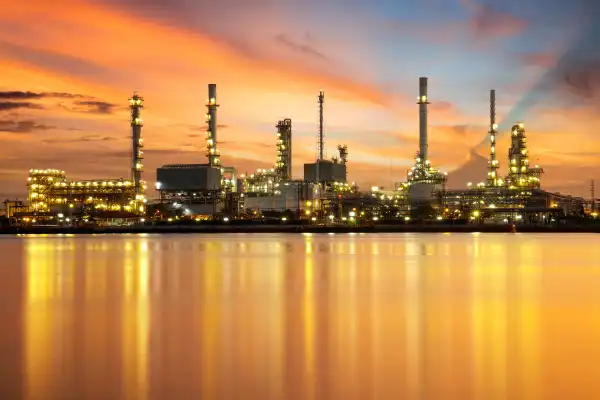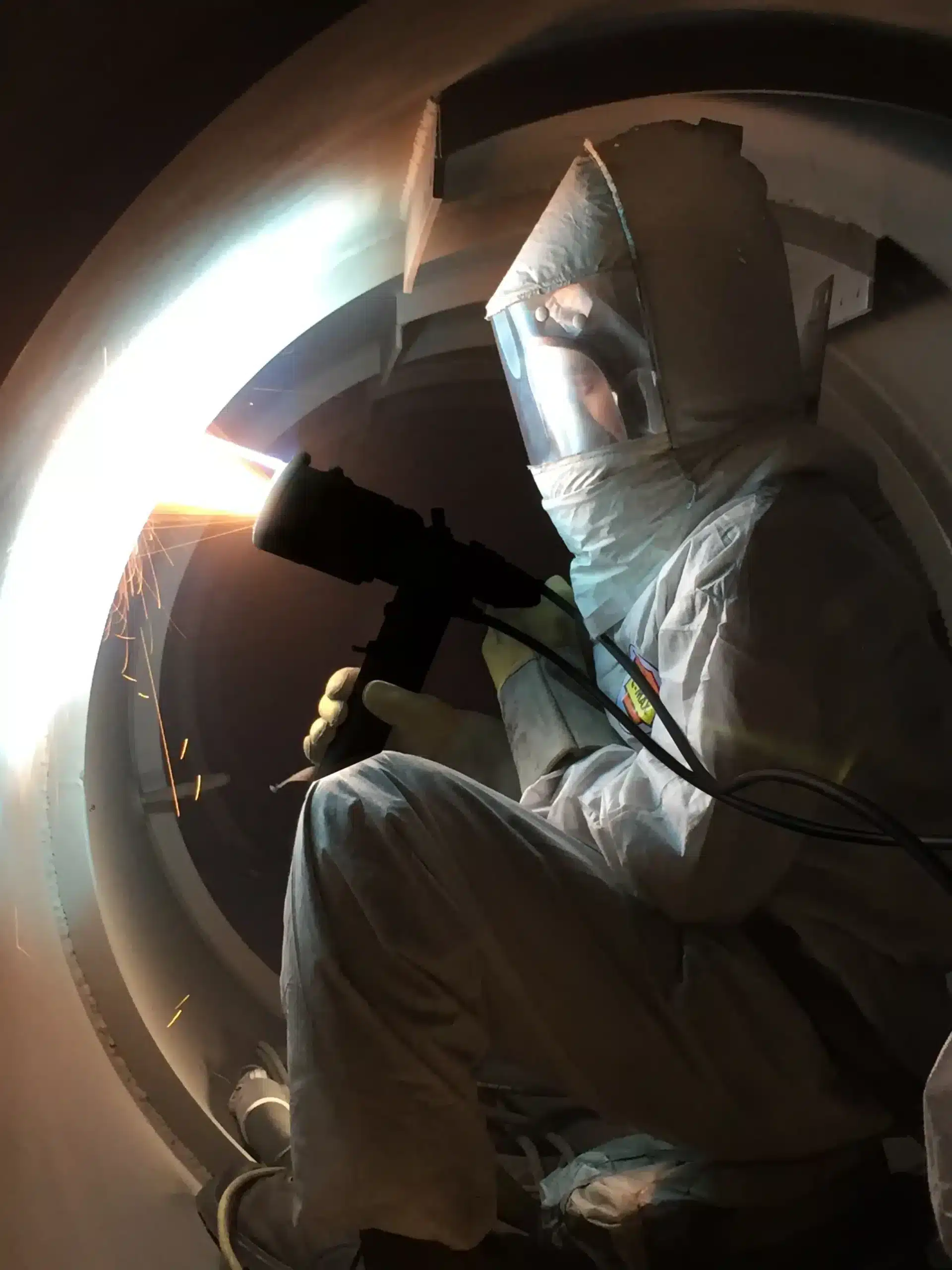Mitigating Corrosion in Amine Vessels
Arrest Internal Corrosion in Amine Systems with IGS HVTS® Cladding
IGS stops amine vessel corrosion mechanisms such as pitting, crevice corrosion, flow enhanced corrosion and general corrosion loss in amine process vessels. We use High Velocity Thermal Spray (HVTS®) applied cladding of high nobility Corrosion Resistant Alloys (CRA’s) in-situ to protect existing amine columns during T/A. Since 2001, IGS has protected dozens of amine units for upstream and downstream operations, internally cladding more than 3000 m² of steel. HVTS® is faster than weld overlay, with no heat-affected zones and no need for PWHT. Unlike organic coating systems, HVTS® metal claddings are robust, long-term, durable solutions for amine system corrosion. With high mechanical toughness, abrasion resistance, and wide service temperature and pressure ranges, HVTS® is resistant to vessel steam out and cleaning processes. We utilize our equipment and technology to apply CRA Metalspray® cladding to stop amine system corrosion almost anywhere in the world.
Amine System Overview
The amine plant is a critical process asset in any oil or gas facility. Its purpose is to remove the corrosive ‘bad actors’ (typically H2S and CO2) from the feed. Amine treating prevents sour or acid gas components from causing major corrosion damage to the equipment downstream in the processing plant. The amine columns are the critical pieces of equipment where the reactions take place to clean up or sweeten the feed. Without the amine plant working, the facility cannot operate, so these units are key to production. Any unscheduled downtime of amine vessels will lead to significant production losses and associated costs.
Amine plants employ a regenerative process to remove acid gas components (H2S or CO2) from the sour feed (typically a gas or light hydrocarbon stream.) A counter-current reactive process is utilized, with an aqueous amine solution in a multistage absorber (contactor) column sweetening the feed. The amine process permits the regeneration of the amine solution by stripping out the acid gas components at a higher temperature in a multistage regeneration (stripper) column, regenerating the amine solution.
Amine Vessel Corrosion Mechanisms
In the amine system, most of the corrosion is related to acid gas breakout and the subsequent attack of the metal surface, usually at elevated temperatures. Since corrosion is a chemical reaction, high temperatures always accelerate corrosion activity because reactions occur faster and more aggressively at higher temperatures.
There are, frequently, several factors contributing to failure by corrosion. Statistics show that almost 50% of corrosion incidents occur in the hottest part of the plant: the reboiler and bottom of the amine regenerator. In amine plants, most corrosion is related to H2S or CO2 breakout and the subsequent attack of the metal surfaces, usually at areas of elevated temperature and a high pressure drop.
More potential corrosion mechanisms exist in amine columns. In the lower section of a regenerator, for example, carbon steel surfaces not wetted by the amine solution may be attacked by water vapor and the formation of carbonic acid. Acid gas ratio, choice of amine (DEA, MEA, MDEA, DGA, AGR, etc.), contaminants, two-phase flow, flashing, high velocities, vessel design, and insulation are all factors at play. Pitting and crevice corrosion, flow enhanced corrosion and general corrosion loss are frequent problems.


Corrosion Mitigation Strategies in Amine Treatment
Many amine towers have the top dome and upper area of the vessel clad with 316 stainless steel as part of the original design. Process control and changes to the feed typically mean that the amine column will experience corrosion in other areas of the vessel, often directly below the clad section. The nature and form of the corrosion mechanism often manifest themselves as a localized pitting attack with high corrosion rates. That can quickly remove the corrosion allowance and damage the integrity of the unit, requiring intervention and mechanical repair to rebuild the pressure boundary.
Aside from operational considerations, several mitigation or repair strategies have historically been employed when internal shell loss occurs. Some mechanical options include installation of temporary clamps and plugs, vessel section replacement, and application of internal weld overlay. The time required for these, together with the Post Weld Heat Treatment (PWHT) required to remove Heat Affected Zones (HAZ) and structural support considerations often demand extended turnaround or shutdown schedules and associated production losses. Temperature and chemical compatibility limitations have prevented the effective use of organic coatings. Due to the nature of the sour feed, loss of containment poses a major safety and environmental risk.
How to Stop Acid Gas Corrosion in Amine Systems
Comparing the effectiveness of corrosion and erosion mitigation technologies in amine systems


Amine Corrosion Management with the IGS HVTS® Corrosion Barrier
IGS has a proven track record approaching 20 years in service experience of stopping internal metal wastage in these critical assets. Since 2001 IGS have protected in excess of 100 amine columns for O&G clients all over the world, internally cladding with IGS HVTS® more than 3000 m² of steel.
In addition to providing a proven solution to stop metal wastage and freeze the internal condition of these key process units, IGS has unparalleled experience in onsite/brownfield HVTS® application, during shutdowns or turn arounds on critical path applications. The installation of an IGS HVTS® cladding maintains asset integrity for the long-term increasing amine vessel availability, providing life extension of the vessel, reducing ongoing maintenance costs, intervention requirements, shutdown scope/schedules, and amine process downtime.
IGS carefully controls and monitors our application standards through strict QC protocols and inspection procedures. In addition, IGS generates an electronic thickness record with mapped electromagnetic stand-off gauge readings on a defined reference grid across the clad area. This record is used for future inspection and verification of the internal cladding integrity. We have developed additional inspection technologies for external, on-line verification of the cladding condition by through vessel wall scanning.
IGS HVTS® cladding systems can be readily inspected visually for any signs of deterioration. There is no need for high-pressure water blast, sandblast or mechanically abrade the cladding for inspection purposes. Unlike organic coating systems, HVTS® metal claddings are a robust, long-term, durable solution with high mechanical toughness, abrasion resistance and wide service temperature and pressure ranges, resistant to vessel steam out and cleaning processes. This substantially decreases life-cycle cost and can extend required inspection intervals, further reducing downtime.
Worldwide On-Site Corrosion Protection of Amine Systems
IGS provides advanced protection to critical process equipment such as amine columns reduces production losses, which is a key cost factor for a refinery. The use of high nobility corrosion-resistant alloys applied with the IGS HVTS® process is deemed more economical when compared to weld overlay and column replacement strategies. Non-metallic coatings are typically not considered due to their inability to reliably achieve a three-year run cycle in this corrosive environment. When you take into consideration the duration of the IGS HVTS® repair solution and reduced future maintenance due to the elimination of recurring corrosion, significant value in millions to tens of millions of dollars has been realized by clients by adopting this technology.
Free consultation with an IGS Subject Matter Expert
IGS is here to provide information, answer questions and create an effective solution for your needs.
